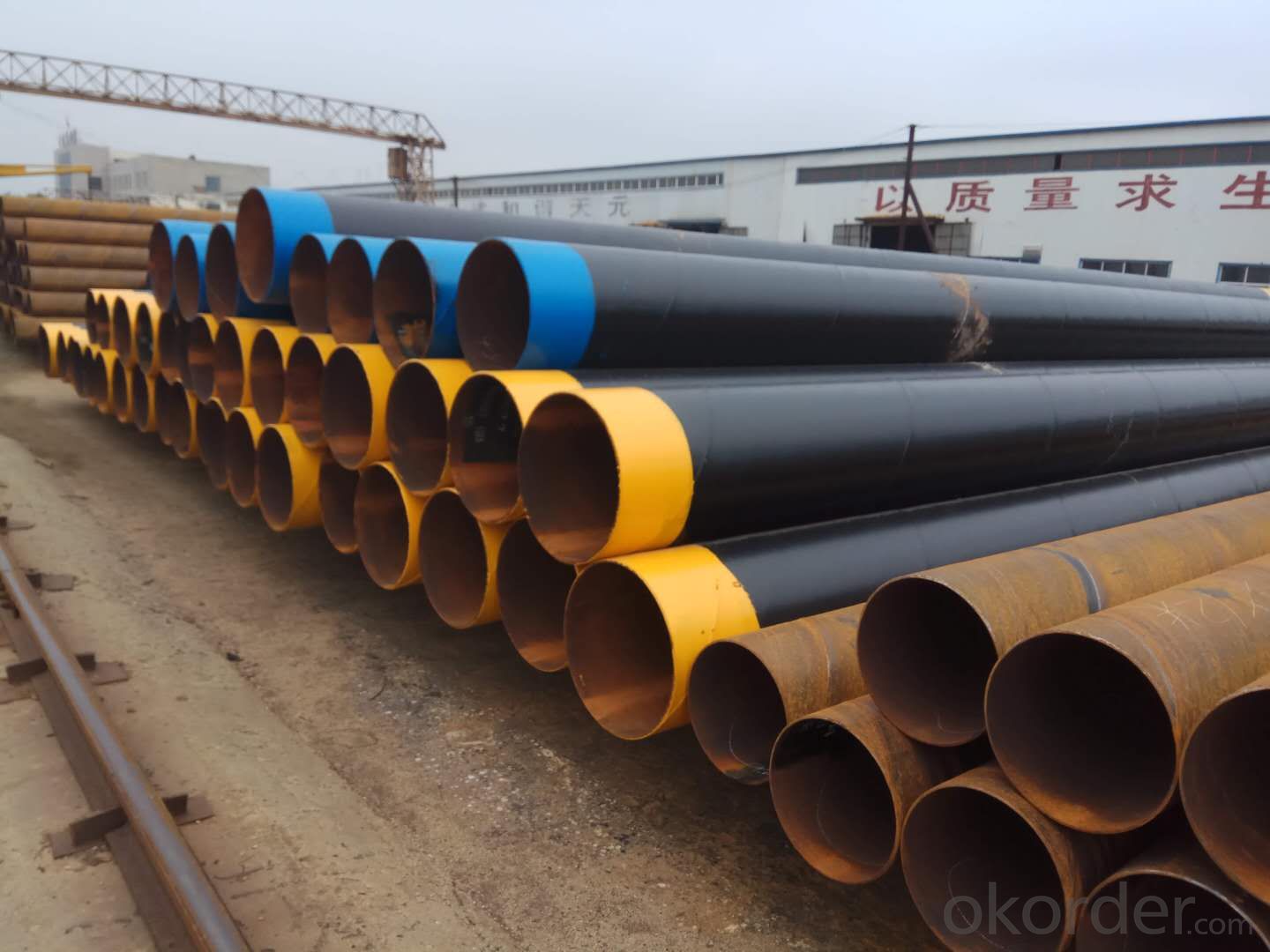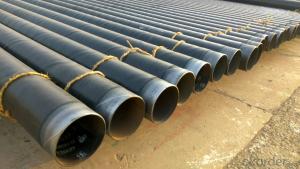Q235b spiral tube 3pe anti-corrosion steel tube
- Loading Port:
- Tianjin
- Payment Terms:
- TT OR LC
- Min Order Qty:
- 453 m²
- Supply Capability:
- 23222 m²/month
OKorder Service Pledge
OKorder Financial Service
You Might Also Like
Item specifice
In view of the excellent comprehensive tenderness of 3PE coating, it has been widely used in the world. For this reason, 3PE anticorrosive steel pipe has become the first choice for coating anticorrosion on these medium pipe projects. The quality control of the anti-corrosion coating of 3PE anti-corrosion steel tube, the process involved in the production of 3PE anti-corrosion coating is more complicated, and there are many factors affecting the product quality. Improper operation of each process can affect the quality of anti-corrosion steel tube. 1. Recommended service life: 3pe anti-corrosion spiral pipe can be used for about 30-50 years in basic cases, while epoxy coal tar anti-corrosion steel pipe has a service life of more than 20 years. Two, the processing technology is introduced: the main raw material of epoxy coal tar anti-corrosion for: coal tar epoxy primer and paint, epoxy coal asphalt cold wind belt of epoxy coal tar anti-corrosion is become people often say the two step, three oil five oil two step, a cloth two oil, epoxy coal tar anti-corrosion steel pipe construction, is applied to steel tube using coal tar epoxy paint, basic USES is painting forms. Click times: 174 update time [close] share: about 3pe anti-corrosion steel pipe manufacturer, base material a is PE jacket layer, base material c is epoxy coating. The adhesive used is a thermoplastic resin type thermoplastic adhesive made of polyethylene and modified by grafting maleic acid, which retains the structure, properties and processing characteristics of polyethylene and has good compatibility and adhesion effect with the jacket material. The production and r&d design of 33pe anti-corrosion spiral pipe is no longer a single paint brush. It should go through many projects such as rust removal, sand blasting, heating and spraying, etc. No less professional equipment should be carried out, and only the production is set up in 3pe anti-corrosion steel pipe manufacturer. Due to the particularity of anti-corrosion layer, professional production line of anti-corrosion steel pipe is needed. Tomorrow small make up special stick you solve you meet of difficult problem, 3pe anticorrosive helix tube price is appropriate very high, quality is not perfect, credit is not high and so on. 1. Production qualification: before purchase, it is necessary to see whether the qualification of 3pe anti-corrosion steel pipe manufacturer is complete, whether it has business license, and whether it has relevant r&d and design qualification. 2. Select material and specification: anti-corrosion steel pipe of what material is required, and consult whether this material is available, that is, whether the material is complete and whether the specification is complete.
The production and r&d design of 33pe anti-corrosion spiral pipe is no longer a single paint brush. It should go through many projects such as rust removal, sand blasting, heating and spraying, etc. No less professional equipment should be carried out, and only the production is set up in 3pe anti-corrosion steel pipe manufacturer. Due to the particularity of anti-corrosion layer, professional production line of anti-corrosion steel pipe is needed. Tomorrow small make up special stick you solve you meet of difficult problem, 3pe anticorrosive helix tube price is appropriate very high, quality is not perfect, credit is not high and so on. 1. Production qualification: before purchase, it is necessary to see whether the qualification of 3pe anti-corrosion steel pipe manufacturer is complete, whether it has business license, and whether it has relevant r&d and design qualification. 2. Select material and specification: anti-corrosion steel pipe of what material is required, and consult whether this material is available, that is, whether the material is complete and whether the specification is complete.
- Q:What are the different types of steel pipe tees?
- There are three main types of steel pipe tees: equal tee, reducing tee, and barred tee.
- Q:How are steel pipes used in the manufacturing of heat exchangers?
- Steel pipes are commonly used in the manufacturing of heat exchangers due to their excellent heat transfer properties and durability. They are utilized as the main components for carrying and transferring hot or cold fluids within the heat exchanger system. The steel pipes ensure efficient heat exchange by providing a smooth and continuous flow of the fluid, while also withstanding high temperatures and pressures. Additionally, steel pipes are often preferred for their corrosion resistance, making them suitable for various industrial applications requiring reliable and long-lasting heat exchangers.
- Q:What is the maximum allowable pressure for steel pipes?
- Various factors, such as the type of steel used, the pipe's diameter and thickness, and specific industry requirements, determine the maximum pressure allowed for steel pipes. The American Society of Mechanical Engineers (ASME) offers guidelines and standards for pressure vessel and piping design, which include determining the maximum allowable pressure. For power piping and process piping, ASME B31.1 and B31.3 are commonly used codes, respectively. These codes establish design criteria for different materials, including steel, and provide formulas and charts to calculate the maximum allowable pressure for different pipe sizes and wall thicknesses. The maximum allowable pressure is typically determined based on the pipe's ability to withstand internal pressure without experiencing permanent deformation or failure. It is important to consider other factors, such as temperature, corrosion, and the presence of external loads or stresses, as they may also impact the maximum allowable pressure for steel pipes. Therefore, it is essential to refer to the relevant codes, standards, and engineering calculations specific to the application to ensure the safe and reliable operation of steel pipes under the given conditions.
- Q:What is the importance of corrosion resistance in steel pipes?
- Corrosion resistance in steel pipes is crucial as it helps prevent the deterioration of the pipes due to chemical reactions with substances in their surroundings. This resistance ensures the longevity and durability of the pipes, minimizing the risk of leaks, clogs, and structural failures. Additionally, it helps maintain the quality and safety of the transported fluids or gases, preventing contamination or degradation. Overall, corrosion resistance in steel pipes is essential for maintaining efficient and reliable infrastructure systems in various industries such as oil and gas, water supply, and construction.
- Q:What is the composition of steel pipes?
- Steel pipes are primarily composed of iron and carbon, with trace amounts of other elements such as manganese, phosphorus, sulfur, and silicon.
- Q:How do you clean and maintain steel pipes?
- To clean and maintain steel pipes, start by removing any loose dirt or debris using a brush or cloth. Then, use a mild detergent or soap solution to wash the pipes thoroughly. Rinse them with clean water and dry them with a soft cloth to prevent water spots. To maintain them, regularly inspect for signs of corrosion or rust and address any issues promptly. Additionally, apply a protective coating or paint to prevent future rusting.
- Q:What are the different methods of pipe joining using steel pipes?
- Some of the different methods of pipe joining using steel pipes include butt welding, socket welding, threaded connections, and flange connections.
- Q:What are the different types of steel pipe flanges?
- There are several types of steel pipe flanges, including slip-on flanges, weld neck flanges, socket weld flanges, threaded flanges, blind flanges, and lap joint flanges. Each type has unique features and is used in specific applications based on factors such as pressure ratings, pipe size, and end connections.
- Q:How do steel pipes connect to other components?
- Steel pipes can be connected to other components using various methods such as welding, threading, flanges, or couplings.
- Q:How to perform nondestructive inspection of steel tubes
- The detection principle is based on the ferromagnetic material is magnetized in a magnetic field, discontinuity materials and products (defects) produce leakage magnetic field, magnetic powder adsorption (or detecting) and appear (or on the instrument display). Therefore, this method can only be used for the inspection of the surface or near surface defects of ferromagnetic materials or products.
1. Manufacturer Overview |
|
|---|---|
| Location | |
| Year Established | |
| Annual Output Value | |
| Main Markets | |
| Company Certifications | |
2. Manufacturer Certificates |
|
|---|---|
| a) Certification Name | |
| Range | |
| Reference | |
| Validity Period | |
3. Manufacturer Capability |
|
|---|---|
| a)Trade Capacity | |
| Nearest Port | |
| Export Percentage | |
| No.of Employees in Trade Department | |
| Language Spoken: | |
| b)Factory Information | |
| Factory Size: | |
| No. of Production Lines | |
| Contract Manufacturing | |
| Product Price Range | |
Send your message to us
Q235b spiral tube 3pe anti-corrosion steel tube
- Loading Port:
- Tianjin
- Payment Terms:
- TT OR LC
- Min Order Qty:
- 453 m²
- Supply Capability:
- 23222 m²/month
OKorder Service Pledge
OKorder Financial Service
Similar products
New products
Hot products
Related keywords































